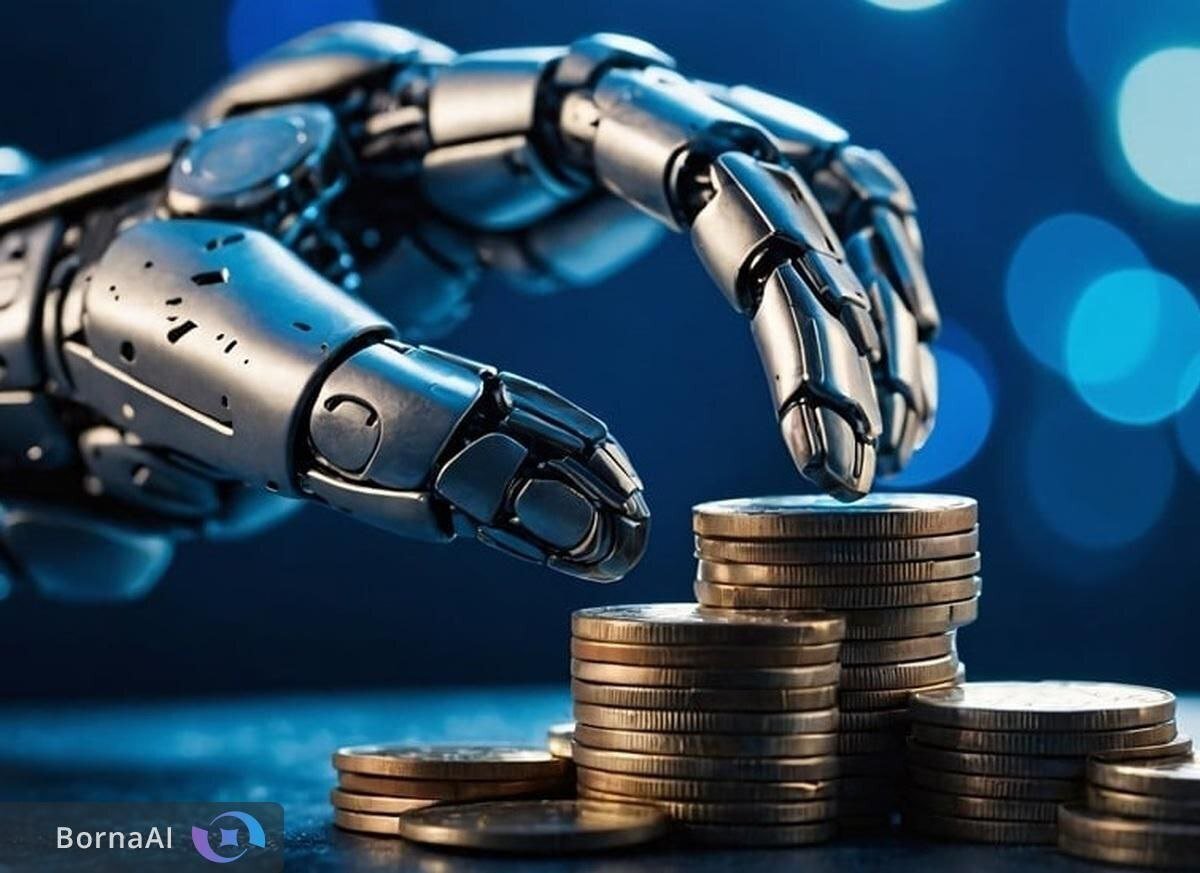AI Insights
When You’re Suddenly Managing More People—and Feeling Buried
AI Insights
How Artificial Intelligence Creates Billionaires

Tehran – BORNA – Artificial intelligence is generating wealth at a speed never seen before, creating dozens of new billionaires and pushing the valuations of startups and tech giants to astronomical levels. This trend has turned AI into the fastest wealth-creation wave of the modern era.
In recent years, AI has evolved from an emerging technology into a global economic and financial powerhouse. This wave is not only transforming industries but also producing unprecedented fortunes. In the current year alone, dozens of new billionaires have emerged from AI-driven companies and startups.
An Unprecedented Investment Boom in AI
Massive funding rounds for AI startups such as OpenAI have pushed company valuations and investor wealth to record highs. Huge venture capital inflows and backing from major investors have created fortunes that are staggering yet real in the tech world. These investments allow private companies to expand rapidly and develop advanced products, while simultaneously fueling the emergence of a new billionaire class worldwide.
According to Andrew McAfee, researcher at the Massachusetts Institute of Technology (MIT), “If you look at the past 100 years of data, we’ve never witnessed wealth creation at this scale and speed.” He argues that this phenomenon is driven by a combination of soaring stock prices at big tech firms and massive investments in young startups unlike anything in modern economic history.
The Role of Big Tech
Major corporations such as Nvidia, Meta, and Microsoft are among the core engines of AI wealth. Their rising stock prices have enriched institutional and retail investors alike, while also benefiting executives and employees. Founders and leaders of AI startups collaborating with these tech giants have seen the value of their equity surge, quickly joining the ranks of the world’s newest billionaires.
The Rise of AI Unicorns
According to CB Insights, there are now 498 private AI companies valued at over \$1 billionthe so-called “AI unicorns.” Together, these firms represent a combined valuation of about \$2.7 trillion. Remarkably, around 100 of them were founded since 2023, highlighting both the rapid pace of AI entrepreneurship and investors’ intense appetite for the sector.
This shows that AI is not only a transformative technology but also a powerful economic and investment driver. Inspired by the success of tech giants and the explosive growth of startups, investors are increasingly willing to pour money into AI ventures.
AI and Personal Wealth Creation
The rapid creation of wealth extends beyond companies. Individuals including founders, executives, engineers, and even startup advisors have quickly joined the global billionaire ranks. Through equity stakes and performance-based rewards, many have significantly boosted their personal fortunes. This demonstrates that in the AI era, financial opportunities are not limited to institutional investors; creative and innovative individuals can also capitalize on this boom.
Economic and Social Consequences
This historic wave of wealth creation carries wide-ranging economic and social implications. On one hand, the concentration of capital and enormous fortunes in the tech sector risks worsening inequality, as wealth increasingly accrues to those with access to investment networks and technological opportunities. On the other hand, greater financial resources for companies and startups accelerate the development of new technologies and services, driving growth and job creation in related industries.
The rapid rise of AI unicorns has also intensified competition between startups and established corporations. Companies now face pressure to continuously innovate, invest in research and development, and secure top talent to maintain their competitive edge. This cycle drives faster technological breakthroughs and the launch of new products and services.
AI and the Future of Investment
Investors and financial experts regard AI as one of the most promising fields for the coming decades. The rapid rise in valuations, the increase in billionaires, and the sheer pace of wealth creation all underscore AI’s status as an unprecedented economic force.
Analysts caution, however, that AI investments carry significant risks. Stock market volatility, potential startup failures, and disruptive technological shifts could quickly erase capital. Yet the sector’s profitability potential and rapid wealth-generation capacity continue to attract global investors.
Artificial intelligence is rapidly becoming one of the world’s most powerful economic and financial engines. It is reshaping industries, fueling an unprecedented wave of wealth, and creating fortunes across corporations, startups, and individuals.
Despite risks and uncertainties, the explosive growth of AI companies, the emergence of new billionaires, and the astronomical valuations demonstrate that AI is shaping nothing less than an economic and investment revolution. For investors, entrepreneurs, and policymakers, the message is clear: AI is not only the technology of the future but also the driving force of wealth creation in the decades ahead.
End article
AI Insights
The future of tennis broadcasting: Excitement-driven AI sports commentary

ProsodyLM was pre-trained on 30,000 hours of audiobooks and ultimately demonstrated better prosody understanding than prior models across various categories. ProsodyLM could, for example, correctly recognize emotion and stress in speech utterances, without being trained to perform those tasks. By explicitly tokenizing the prosody information and content, the resulting language model can generate very expressive speech, develop a preliminary understanding of emphasis and emotion and successfully clone the styles in reference speech.
“Now, instead of AI commentators that speak in a monotone level of excitement and sound unnatural to audiences, these tools can express a high excitement level just like human commentators, who get much more expressive during a very exciting rally,” Zhang said.
Looking forward, once the prototype has advanced to production and excitement-driven sports commentary is rolled out in official tennis tournaments, a next step could be letting fans personalize the sports commentary, Feris said. For example, fans could decide if they want high versus low excitement commentary. In the meantime, Zhang said, the team is receiving a lot of interest from researchers and clients working on other sports like Formula 1 car racing.
In addition, this excitement-driven AI sports commentary was part of an IBM “Behind the Scenes” 2025 US Open demo this year of emerging tennis technologies. This means that in the not-so-distant future, you might want to tune in more closely to see if you can detect whether it’s a human or an AI announcer whipping up the crowd after an overhead smash or a tricky drop shot.
AI Insights
Bristol City Council’s use of AI for creative booklet criticised

Carys NallyBBC News, West of England
 Adam Birch
Adam BirchDesigners have criticised a council after it used artwork created by Artificial Intelligence (AI) to promote adult learning courses.
Illustrator Adam Birch complained to Bristol City Council after it released a course guide with an AI cover, adding that using AI to tell people about creative workshops “devalues” the classes.
But he also said it might have been misguided rather than “malicious”.
Bristol City Council leader Tony Dyer said it was updating its guidance around AI and understood the issue raised.
Mr Birch made it clear he does not want the booklet’s AI cover to deter people from taking the creative courses.
He said: “My big concern about it was – is it sending the wrong message?
“Why learn these [creative] skills if, right on the face of the book, you’re devaluing the use of it?”
Mr Birch said there are certain “mistakes” that let the viewer know an image has been created by AI.
“Extra or missing fingers and toes is always a dead giveaway,” he said.
“On the cover [of the booklet], the lady only has four fingers and I think seven toes.”
 Adam Birch
Adam BirchMr Birch, who creates illustrations for various outlets, said it was not lost on him that he has got to “move with the times” as an artist.
“I appreciate it from all angles,” he said. “This [cover] cost next to nothing to generate.
“But it would have cost next to nothing to take a photo of one of the classes going on – or used some work from the classes as the material on the cover.
“What you’re doing is wiping out a job.”
 @timbirkbeckphotos
@timbirkbeckphotosLuke Oram, an artist and illustrator from Wick, in South Gloucestershire, said he believed AI will affect young people trying to get a start in the creative industry.
“I worry about the 22-year-old graduate who has no idea how to get into a career, or how to even find any work, who then just feels completely undervalued,” he said.
“[They’ll be] alienated from the culture they’re working in because those opportunities just aren’t common anymore.”
“It’s the erosion of knowledge,” he added. “[AI] is damaging.”
Despite this, some in the creative industry have told the BBC there’s a pressure to use AI.
An artist working from Leamington Spa, who wanted to remain anonymous, said his CEO is now recommending his company use AI in their work.
“We’re being told to bring our heads out of the sand,” he said.
“But the people who will be enriched by AI are at the top. For the people expected to use it, they see it as the opposite of what we should be doing.”
He added: “AI is ‘fast-food’. We never stop to think about whether we should – it’s always whether we could.”
Council ‘understands issues’
The creative course booklets were distributed in July and a total of 72,000 were printed.
Up to 70,250 booklets went to individuals and organisations in Bristol, with a few to South Gloucestershire and North Somerset postcodes.
There are no plans for any further print runs.
Mr Dyer said the council fully understands the issues raised.
“While AI presents exciting opportunities for local authorities to improve and adapt their services, we recognise the strong feelings expressed by residents over our use of AI-generated imagery for this booklet,” he said.
“We are currently trialling some limited use of AI and developing our policies and procedures as we learn.”
Mr Dyer added that since the imagery for the booklet was commissioned, the council has updated its guidance for the use of AI.
-

 Business4 days ago
Business4 days agoThe Guardian view on Trump and the Fed: independence is no substitute for accountability | Editorial
-
Tools & Platforms3 weeks ago
Building Trust in Military AI Starts with Opening the Black Box – War on the Rocks
-

 Ethics & Policy1 month ago
Ethics & Policy1 month agoSDAIA Supports Saudi Arabia’s Leadership in Shaping Global AI Ethics, Policy, and Research – وكالة الأنباء السعودية
-

 Events & Conferences3 months ago
Events & Conferences3 months agoJourney to 1000 models: Scaling Instagram’s recommendation system
-

 Jobs & Careers2 months ago
Jobs & Careers2 months agoMumbai-based Perplexity Alternative Has 60k+ Users Without Funding
-

 Funding & Business2 months ago
Funding & Business2 months agoKayak and Expedia race to build AI travel agents that turn social posts into itineraries
-

 Education2 months ago
Education2 months agoVEX Robotics launches AI-powered classroom robotics system
-

 Podcasts & Talks2 months ago
Podcasts & Talks2 months agoHappy 4th of July! 🎆 Made with Veo 3 in Gemini
-

 Education2 months ago
Education2 months agoAERDF highlights the latest PreK-12 discoveries and inventions
-

 Podcasts & Talks2 months ago
Podcasts & Talks2 months agoOpenAI 🤝 @teamganassi


